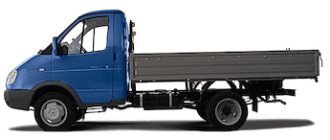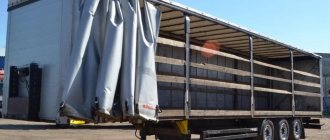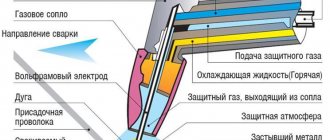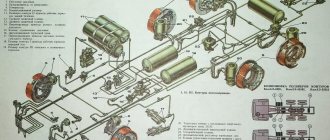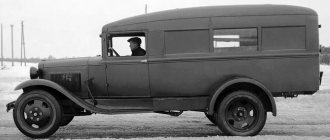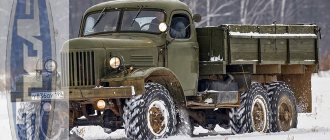ZIL 4502 is a two-axle truck with an all-metal body. The car was in great demand among consumers and was widely distributed throughout the USSR. Despite the fact that the production of the ZIL 4502 ended quite a long time ago, you can still find this equipment on the roads of the country today.
ZIL 130 was widespread in the mid-20th century. The product line of the Likhachev plant grew rapidly due to the emergence of new versions based on this car. ZIL 4502 was also based on the ZIL 130 chassis and was a shortened version of it. Production of the model began in 1975 at the Mytishchi Machine-Building Plant. The equipment quickly gained popularity due to its high maneuverability and reliability. The car remained in the brand's lineup until 1994. The model is most widely used in agriculture, construction and industry.
Description and modifications of ZIL-4502
The chassis model on which the Mytishchi dump truck is based is “scientifically” called ZIL-130D1, produced by the Ivan Likhachev Moscow Automobile Plant.
The purpose of the ZIL-MMZ-4502 dump truck is to transport all kinds of national economic cargo (mainly bulk and bulk) along any type of highway and light off-road conditions.
Based on the ZIL-MMZ-4502 dump truck, the following modifications of this truck model were produced:
- ZIL-MMZ-45021 is a dump truck on a 311L-130K chassis with a linear 6-cylinder ZIL-157D engine with a power of 110 hp. With.
- ZIL-MMZ-45022 is a dump truck on the ZIL-130D2 chassis, which is equipped with a combined brake valve, a hydraulic distributor to control the tipping of the body of the vehicle itself and the trailer; towing device, hydraulic, pneumatic and electrical outlets for connecting the corresponding trailer systems.
That is, one is designed for independent operation without a trailer, and the other is for use with a trailer, also equipped with a dump cargo platform.
During production, they were gradually modernized, along with which the carrying capacity of the ZIL-4502 dump truck increased.
Here is how these characteristics of the car changed: in 1976-1977. – 5000 kg; in 1977-1980 – 5250 kg; in 1980-1986 – 5800 kg; in 1986-1994 (on ZIL-495810 chassis) – 6000 kg.
Accordingly, the total weight of the trailer towed by the car varied “according to the passport” from 7215 kg...7475 kg...7500 kg...8000 kg.
The ZIL-4502 dump truck was equipped with a straight-sided metal body with an opening tailgate. In front of this dump cargo platform there was a visor that protected the cabin from cargo falling on it, as well as locks that were adjustable in manual and automatic modes.
Modifications
The debut batch of ZIL 4502 rolled off the assembly line in December 1975. A month later, mass production of the car began. Along with the modernization of the ZIL 130 series, the ZIL 4502 also changed. The vehicle was successively produced on the ZIL 130D1-66, ZIL 130D1-76 and ZIL 495810 chassis. At the same time, the characteristics of the vehicle changed:
- load capacity on the ZIL 130D1-66 chassis (January 1975 - April 1977) - 5000 kg;
- load capacity on the ZIL 130D1-76 chassis (April 1977 - December 1980) - 5250 kg;
- load capacity on the ZIL 130D1-76 chassis (December 1980 - January 1986) - 5800 kg;
- load capacity on the ZIL 495810 chassis (January 1986 - 1994) - 6000 kg;
ZIL 4502 was offered in 2 main versions:
- ZIL 45021 – modification not intended for use with a trailer;
- ZIL 45022 is a model with a towing device and the ability to connect a trailer drive system (hydraulic, electric, pneumatic). This dump truck was also equipped with a hydraulic distribution system and a combined type brake valve.
Engine ZIL-4502
The engine of this truck is a four-stroke, carburetor, V-shaped, overhead valve, eight-cylinder, with the cylinders located at an angle of 90 degrees relative to each other. Engine model – ZIL-508.
Its technical parameters in numbers:
- Cylinder diameter – 100 mm, piston stroke – 95 mm.
- The working volume of the cylinders is 6 liters.
- Compression ratio – 6.5.
- Rated power, at 3200 rpm – 110.4 kW (150 hp)
- Maximum torque at 1800-2000 rpm – 401.8 N*m (41 kgf*m).
- The minimum specific fuel consumption is 313 g/(kW-h) / 230 hp-h).
- The operating order of the cylinders is: 1-5-4-2-6-3-7-8.
- Cylinder numbering: right group – 1-2-3-4, left group – 5-6-7-8.
- Dry weight of the engine (with clutch, gearbox, parking brake system, compressor, power steering pump and fan) – 640 kg.
The cylinder block of the ZIL-508 engine is cast iron, with easily removable insert liners, with rubber sealing rings in their lower part. This engine has two cylinder heads, made of aluminum alloy, with insert seats and valve guides.
The pistons are made of aluminum alloy. Piston rings: three compression rings - cast iron (two upper ones - chrome-plated) and one steel oil scraper, composite, chrome-plated. Piston pins are steel, floating, hollow.
The connecting rods of the ZIL-508 engine are steel, I-section, with piston pin lubrication by splashing. Connecting rod and main bearings are thin-walled, interchangeable; liners - steel-aluminum (steel tape, aluminum alloy). The engine crankshaft is steel, forged, 5 bearings, with lubrication channels; necks with dirt traps.
The flywheel is made of cast iron, equipped with a steel ring gear to start the engine from the starter. The camshaft is steel, 5-bearing.
Valve timing: intake valve opening – 31° BTDC; intake valve closing – 83° after BDC; exhaust valve opening – 67° to BDC; exhaust valve closing – 47° after TDC.
The camshaft is driven by a gear pair with oblique teeth; the wheel is cast iron.
The valves of the ZIL-508 engine are upper, located in the cylinder heads. They are driven by a single camshaft. Exhaust valves are hollow, cooled, with heat-resistant surfacing; having a mechanism for forced rotation of the valve during operation.
The pushers are mechanical, steel, coated with special cast iron. The valve rocker arms are steel, with a bronze bushing. Gas pipelines: intake - made of aluminum alloy, common to both rows of cylinders, with a liquid cavity for heating the fuel mixture, located between the cylinder heads; graduations - cast iron; 1 on each side of the BC.
The engine lubrication system is of a mixed type: under pressure and splash, with cooling of the engine oil in the radiator.
The oil pump is a gear, 2-section, located on the right side of the cylinder block. The upper section of the oil pump supplies oil through the oil filter to the engine lubrication system. The pressure reducing valve of the upper section is set to a pressure of at least 320 kPa (3.2 kgf/cm2). The lower section of the pump supplies oil to the oil cooler; the bypass valve of the lower section is set to a pressure of 120 kPa (1.2 kgf/cm2)
The oil filter is centrifugal, with a jet drive. The oil radiator is air-cooled, made of finned aluminum tube, installed in front of the water radiator.
Engine crankcase ventilation is forced, with crankcase gases being sucked into the intake gas pipeline through a special valve. Air flows through the oil filler neck filter.
The engine fuel supply system is a forced supply of gasoline. Fuel pump - model B10, diaphragm, with a lever for manual pumping of fuel.
Heating of the fuel mixture is located in the intake gas pipeline, which has a liquid cavity for heating the fuel.
Gasoline purification filters: main sediment filter (slotted, located on the fuel tank bracket); fine filter (with a ceramic filter element, located on the bracket in front of the carburetor), and a fuel tank filter (mesh, located on the receiving tube).
The carburetor used is the K-88AM model, 2-chamber, with a falling mixture flow, having an accelerator pump and an economizer.
The limiter of the maximum engine crankshaft rotation speed is a pneumatic centrifugal converter and an actuating diaphragm mechanism with a pneumatic drive.
Air filter – VM-16, oil-inertia, with two-stage air purification.
Also, ZIL-4502 cars of the first years of production were equipped with six-cylinder carburetor engines of the ZIL-157D model. For objective reasons, not a single one of these machines has survived to our times.
The working volume of the cylinders is 5.38 liters. Cylinder diameter – 100 mm, piston stroke – 114.3 mm. Rated operating power at 2800 min-1 - 81 kW (110 hp). This engine ran on 72-octane gasoline. And the more powerful eight-cylinder, in favor of which the choice was ultimately made, is on the 76th
Calculation of body volume for transporting sand
When loading the machine, consider the density of the material. The sand is heavy. The technical characteristics of the ZIL 130 allow the dump truck body volume to be loaded up to a maximum of 5 tons. Sometimes drivers allow loading up to 6.5 tons, knowing that their car has such a technical capability.
How much volume of a ZIL body will sand weighing 5 tons take up?
The density of the sand mass ranges from 1400 to 1800 kg/m3. For calculation, an average value of 1600 kg/m3 is usually taken.
To prevent overloading the machine, you need to determine how many cubic meters of sand are contained in five tons. To do this you need to perform a simple calculation:
5000:1600 = 3.125 m³, or maximum load:
6500:1600 = 4.063 m³.
The density of sand can be determined more accurately by an experimental method. To do this you need:
- take an ordinary bucket with a capacity of 10 liters, fill it with sand and weigh it;
- weigh the bucket without sand;
- subtract the tare weight from the total weight;
- divide the resulting value by 10 - this will be the density of the sand in t/m³.
Transmission ZIL-4502
The transmission of this truck model includes a manual gearbox with five stages and constant mesh gears (except for reverse and 1st speed).
Two synchronizers are installed in all gears except first. Torque is transmitted using a dry-type single-plate clutch and driveshaft. The ZIL-4502 dump truck has a shortened base, which is why the design has one shaft without an intermediate support. The driven shaft is equipped with a front bearing.
Calculation of body volume for transportation of building materials
The calculation of crushed stone is carried out similarly to the previous one using the density indicator:
Actual load capacity
- when transporting 6.5 tons of crushed stone (1300 kg/m³), the number of its cubes in ZIL will be: 6500 kg: 1300 kg/m³ = 0 m³;
- when transporting crushed stone (1500 kg/m³) cubes in ZIL there will be:
6500 kg: 1500 kg/m³ = 4.33 m³.
Both cases do not require a volume of more than 5 m³.
For each type of bulk materials, it is possible to calculate the capacity for loading into a certain type of transport, using data on their density.
Table of density values for some types of crushed stone:
| Name of crushed stone | Density, kg/m³ | Cubes in 1 ton of material |
| Granite | 1470 | 0.680 |
| Gravel | 1400 | 0.714 |
| Sandstone | 1300 | 0.769 |
| Terricone | 1150 | 0.870 |
| Marble | 1500 | 0.667 |
| Limestone | 1300 | 0.769 |
| Tuff | 800 | 1.250 |
| Slag | 1500 | 0.667 |
Tuff crushed stone with a body of 5 cubic meters can be transported accordingly:
5 x 800 = 4000 kg (4 tons).
When making calculations, it must be taken into account that the density of building materials also depends on some parameters:
- high humidity - it increases the weight of the same amount of material;
- the presence of various impurities that can make the material heavier or lighter;
- fraction sizes. There is a single scale for determining standard parameters in each individual case.
Brakes and electrical equipment
All wheels of this car were equipped with drum brakes, which operate using a pneumatic system. In this case, constant pressure in the air reservoir of the brake system is maintained by a mechanical compressor, which operates from the water pump pulley. The cooling system includes two twenty-liter cylinders. The braking system also includes a parking brake, which, when active, locks the driveshaft.
The ZIL-4502 trucks used a standard electrical system with a 12-volt mains voltage. Power is provided by a battery and a generator.
Truck device
Under the designation 4502, rear-wheel drive cars with a 4x2 wheel arrangement were produced. They were equipped with a metal cabin on a frame structure and a body with a hydraulic tipping device.
A ZIL-508.10 carburetor engine was installed under the hood. The braking system is represented by drum brakes on all wheels. The steering wheel is equipped with a hydraulic booster. The suspension is dependent, the front is a beam, the rear is leaf spring.
The technical characteristics of the ZIL MMZ 4502 made it a universal vehicle for transporting a variety of cargo in urban and suburban environments. Today it can still be found at country construction sites, on agricultural farms, and among private entrepreneurs. The model has long been outdated, but the low price still attracts buyers, especially those who are interested in the Soviet automobile industry and are willing to put up with frequent repairs and a low level of comfort.
Technical characteristics of ZIL-4502 in numbers
- Overall dimensions: length – 5500 mm, width – 2400 mm, height – 2500 mm.
- Wheelbase – 3300 mm.
- Ground clearance – 270 mm.
- Front track width – 1800 mm; rear track - 1790 mm.
- Body, internal dimensions: length – 2600 mm, width – 2300 mm, height – 635 mm; body volume without extension sides – 3.8 cubic meters; with standard extension sides - 5.1 cubic meters. Body lift angle – 50 degrees; lifting time for a loaded body – 15 seconds; empty body lowering time – 20 seconds.
Depending on the modification, the ZIL-4502 dump truck in running order weighs 4750...4825 kg. The total weight of ZIL 45021/ZIL 45022 is 9975...10300 kg. With a maximum body load, the car can accelerate to a speed of 90 km/h.
This dump truck has one fuel tank. It has a volume of 170 liters and is installed under the cargo dump platform, on the left side member.
Body characteristics
The body is straight-sided, made of metal. The tailgate opens. The locks can be controlled in automatic and manual modes. There is a canopy to protect the cabin. Internal dimensions of the body:
- Length - 2600 millimeters.
- Width - 2300 millimeters.
- Height - 635 millimeters.
The body volume is 3.8 cubic meters. With extension sides installed, it increases to 5.1 cubic meters.
The body rises at an angle of fifty degrees. This takes fifteen seconds if the body is loaded. The empty body lowers in twenty seconds.
As you can see, the ZIL-MMZ-4502 car has good technical characteristics. This allowed him to gain recognition among many users. He was so loved that his exploitation continues to this day.
Body (dump cargo platform)
The body of the ZIL-4502 truck is metal, welded. In its manufacture, bent profiles were used.
The rear side of the body can be opened on both upper and lower hinges. The side boards are simply welded to the base. On the rear and side sides there is the possibility of installing additional extension (metal) sides.
The body is supported at the rear by brackets on the tipping shaft, due to which the body is articulated with the subframe.
In the middle part there are special body supports, and in the front part there are body supports with rubber buffers. The tailgate locks can be controlled either automatically or manually.
The hooks of the tailgate locks are controlled using transverse shafts mounted on the underside of the base of the body, which are connected to each other by an adjustable rod and a bracket.
In turn, the locking hooks are connected to the shaft through adjustable rods and brackets. When the shaft is turned clockwise, the side is locked, and when turned counterclockwise, it is unlocked. The shaft is rotated either manually using a handle, or automatically using a shaped lever.
The main components of a dump truck are: a hydraulic tipping device, consisting of: power take-off, pump, control valve (dump trucks ZIL-MMZ-4502, ZIL-MMZ-45021); hydraulic valve (dump truck ZIL-MMZ-45022), hydraulic cylinder, limit valve, hydraulic tank and pipelines.
The power take-off, together with the pump installed on it, is mounted on the gearbox hatch on the right side. The main parts of the power take-off are the housing, the intermediate gear mounted on bearings on a longitudinally moving axis, and the driven gear, which is mounted on bearings and is in constant mesh with the intermediate gear. The control valve has a plunger-spool, safety and check valves.
Prices and analogues
The last cars were assembled in the first half of the 90s, so new equipment is not on sale. The truck was not delivered to the army; there are no converted copies from storage. On the secondary market, the price for a ZIL-4502 dump truck starts from 120 thousand rubles. Cars after overhaul, equipped with diesel engines, are estimated at 250-300 thousand rubles. Analogues are the MMZ-4503 or 4504 models, which are distinguished by a cargo platform with 3-sided unloading.
ZIL 4502 is a two-axle truck with an all-metal body. The car was in great demand among consumers and was widely distributed throughout the USSR. Despite the fact that the production of the ZIL 4502 ended quite a long time ago, you can still find this equipment on the roads of the country today.
ZIL 130 was widespread in the mid-20th century. The product line of the Likhachev plant grew rapidly due to the emergence of new versions based on this car. ZIL 4502 was also based on the ZIL 130 chassis and was a shortened version of it. Production of the model began in 1975 at the Mytishchi Machine-Building Plant. The equipment quickly gained popularity due to its high maneuverability and reliability. The car remained in the brand's lineup until 1994. The model is most widely used in agriculture, construction and industry.
Hydraulic equipment
The hydraulic distributor of the ZIL-MMZ-45022 dump truck is designed to control the unloading of dump truck bodies and dump truck trailers. The hydraulic distributor is mounted under the cab floor and is connected by pipelines to the pump, hydraulic tank and hydraulic cylinder, as well as to a pipeline (for connecting the hydraulic system of the dump trailer tipping device).
Two spools are located in the bores of the hydraulic distributor housing. Each of them controls one hydraulic cylinder (of a dump truck or dump trailer). The spools can be installed in 4 positions using the steam distributor handles, which are located in the dump truck cab. In this case, the front handle of the hydraulic distributor moves the spool that controls the hydraulic cylinder of the dump truck, and the rear handle moves the spool that controls the hydraulic cylinder of the dump trailer.
The hydraulic cylinder is attached to the subframe and body brackets in the form of ball joints and is carried out using ball joints and ball heads screwed into the retractable link and bottom and secured with retaining rings.
To prevent the hydraulic cylinder from rotating around the longitudinal axis, a link is attached to the body, which fits into a special groove in the bracket of the lower support of the hydraulic cylinder.
The hydraulic tank of the ZIL-4502 truck is stamped and welded. It is mounted on the right side of the car, under the spare wheel holder beams. The upper half of the hydraulic tank has a filler neck with a strainer. It is closed with a breather, which has an air filter and an indicator for measuring the oil level in the hydraulic tank. It is marked “B” and “H”, which correspond to the maximum and minimum oil levels.
To supply oil to the components of the hydraulic tipping device, steel pipes and flexible hoses of high and low pressure are used. The hydraulic systems of a dump truck and its dump trailer are connected using a locking device.
Design features. Closest relatives – ZIL-4514, ZIL-4516
The basis of the ZIL 4520 dump truck is the base chassis ZIL-133D42 produced by the capital's Likhachev Automobile Plant. This three-axle chassis was originally intended specifically for the ZIL-4514 construction dump truck. This model was put into production in 1993. Cargo dump truck ZIL-4514 – Neftekamsk dump truck plant, absolutely similar to the one installed on three-axle KamAZ-55111 dump trucks. ZIL-4514 dump trucks were produced from 1993 to 1997, and cargo platforms were installed on the ZIL-133D42 chassis not only by the Neftekamsk plant, but also by the Orsk tractor trailer plant (although the latter, of course, produced much fewer such vehicles).
Recognizable KamAZ body on ZIL 4514
Another manufacturer of dump truck platforms (metal body and hydraulic tipping device for unloading the body) - Mytishchi Machine-Building Plant - also began installing its own version of a dump truck on the ZIL-133D42 chassis, in the same 1993. The result is a new version of the universal industrial construction dump truck - ZIL-MMZ-4520. The Mytishchi body with a rounded “trough-shaped” lower part is significantly different from the NefAZ one - bucket-shaped, angular.
Mytishchi version: ZIL 4520.
The loading platform of the ZIL-MMZ-4520 dump truck was specially made with these bevels on the side sides to prevent sticking of the transported wet bulk cargo. Control of the hydraulic tipping device: activation of the power take-off and pump is remote, electro-pneumatic from the driver’s cabin; The hydraulic distributor is activated manually from the driver's cab.
An agricultural dump truck was also developed on the ZIL-133D42 base chassis: ZIL-MMZ-4516. This version of the ZIL three-axle dump truck received a loading platform with the ability to unload on the western side. It was designed for transportation and quick unloading of grain and other agricultural cargo along public roads, including unpaved roads and in field conditions. The configuration of this vehicle included the installation of an awning on the body to ensure the safety of the cargo.
Agricultural dump truck ZIL-4516 at work.
Salon
The cabin in the car is designed for three seats, including two passengers. Unlike the GAZon of those years (and this is the 53rd model), there is no common sofa. The driver's seat is separated from the passenger seats. The seat itself is devoid of any lateral or lumbar support. It was very difficult to drive this car over long distances. The cabin does not have any noise or thermal insulation.
In winter it cooled down quickly, and on the way you could hear the constant noise of the engine. There is no plastic trim in the interior. The doors and front panel are part of the cabin and are made of bare metal. There is a solid rubber mat on the floor. By the way, craftsmen laid Soviet linoleum here. The instrument panel is quite archaic. The steering wheel has no adjustments. In the center of the panel there is a small glove compartment with technical inscriptions. In general, the ZIL cabin was similar to GAZON's, both in terms of comfort and the location of controls.

